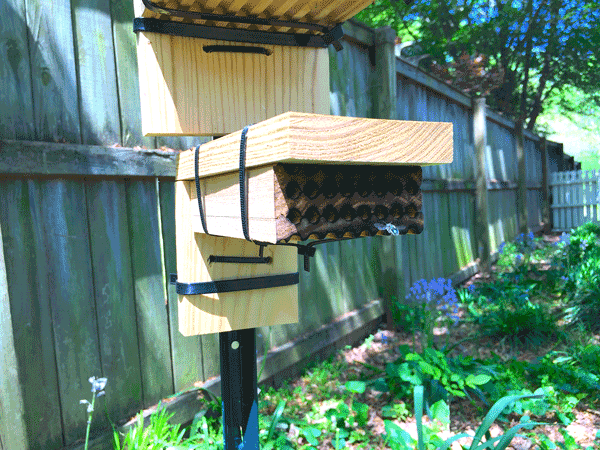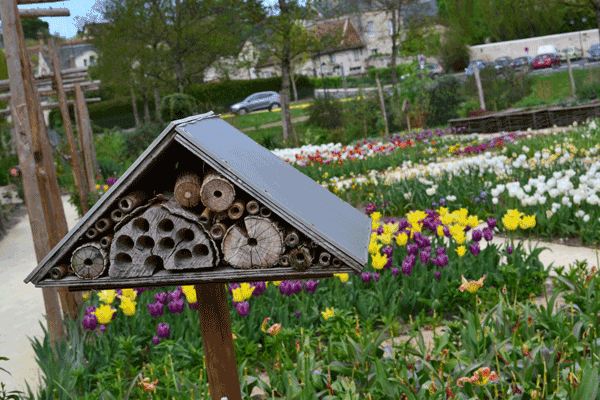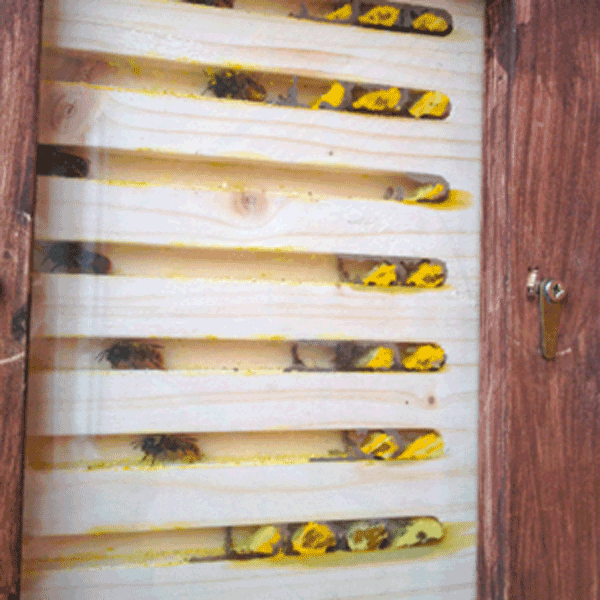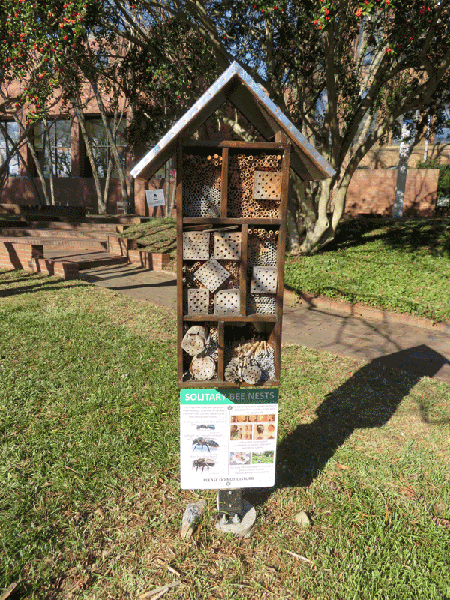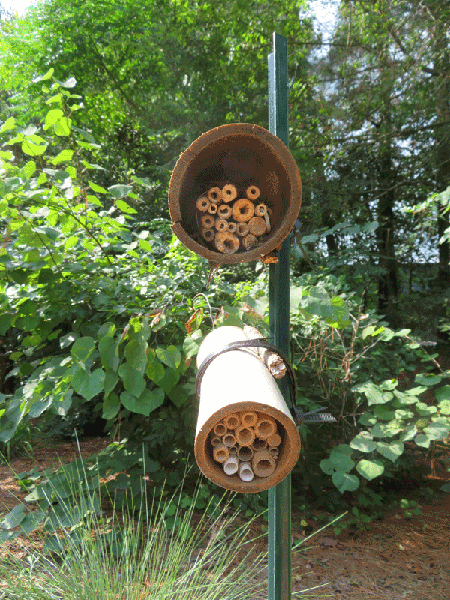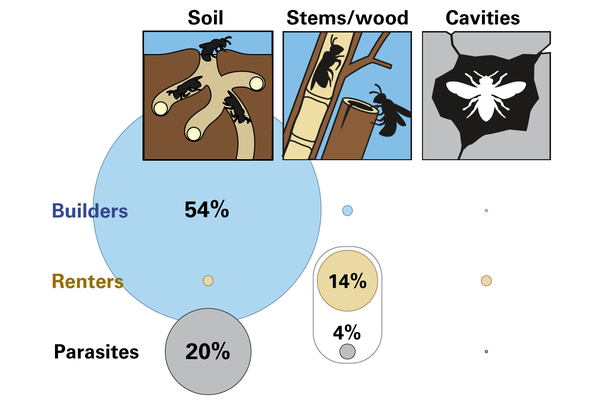Introduction
Bee hotels are the insect equivalent of a birdhouse. Also known as bee condos, bee houses, or nest blocks, these structures provide nesting spaces for certain solitary bees and wasps. These species would ordinarily nest in hollow plant stems, holes in dead wood, or other natural nooks and crannies. A bee hotel simulates this nesting habitat by providing a bundle of hollow reeds or stems, or holes drilled in a wooden block. These nesting tunnels can be sheltered from weather and predators using a variety of structures (Figure 1A, 1B, 1C, 1D, 1E, 1F, 1G).
Managing a bee hotel can be simple and rewarding, but it does require some planning, maintenance, and commitment. This document will guide you through the process of choosing a hotel design and location, identifying its occupants, and maintaining a safe environment for them. We will emphasize practices relevant to small-scale bee hotels used to enhance pollination of home gardens, to provide habitat, or for observation. Large-scale production of bees for commercial pollination is not covered.
If you’re in a hurry or just need a quick review, you can skim for the “best practices” boxes or use the bee hotel checklist in Appendix 1.
The Benefits of Bees
A common motive for installing a bee hotel is to support bee populations and the pollination services they provide. Bees are among the most abundant and effective pollinators in natural and agricultural habitats. Their activities help plants reproduce, creating the fruits and seeds that we eat. About 87% of all flowering plant species and 75% of crop species benefit from an animal pollinator for production of seeds or fruit (Ollerton et al. 2011; Klein et al. 2007). Even so, we would not starve without bees. Bees are directly responsible for only about 3% to 8% of our total food supply (Lorenzo-Felipe et al. 2020; Aizen et al. 2009), and staple crops such as wheat, corn, and rice are wind-pollinated and do not rely on insect pollinators. These estimates do not include indirect effects of bee pollination, such as enhancing the yield of alfalfa, which is essential forage for livestock such as cows raised for milk or meat. Bees and other animal pollinators are essential for many fruits, nuts, and berries, which are packed with nutrients and provide the majority of vitamins A and C in our diet (Eilers et al. 2011; Smith et al. 2015). Overall, our food supply would be smaller, less colorful, and less nutritious without bees.
Native Bees Are Effective Pollinators
Honey bees are the main pollinators in commercial agriculture, but they do not use bee hotels. Native bees and other animals, however, also provide important pollination services and enhance pollination even when honey bees are present. Depending on the scale of agriculture, native bees can be sufficient for pollination needs and can be more efficient than honey bees at pollinating specific crops (Eeraerts et al. 2020; Danforth et al. 2019). For example, between 250 and 300 blue orchard bees (Osmia lignaria) can pollinate the same acreage suggested for 1 to 2.5 strong honey bee hives, which contain on average about 30,000 bees per hive (Bosch and Kemp 2001).
Native bees vary in dietary habits, and this variety can make them effective as a group for pollinating a diversity of plants. Some native bees are dietary generalists, such as bumble bees, which are active throughout much of the year and use various plants throughout the seasons. In contrast, some bees are dietary specialists and collect pollen only from select plants. For example, the squash bee, Eucera (Peponapis) pruinosa, is a dietary specialist and collects pollen and nectar solely from plants in the genus Cucurbita, such as squash and pumpkins.
Pollination in Cities and Towns
We need bees not just on our rural farms, but with us in the cities and suburbs where most people live. Urban farms and community gardens are growing in the US (Santo et al. 2016; Armar-Klemesu 2000; Leake et al. 2009; Langellotto 2014; Wortman and Lovell 2014; Taylor and Lovell 2012; Lovell 2010). Moreover, many plants in parks and ornamental gardens also rely on insect pollination. Urban pollination is threatened by overall bee decline and by mismatches in pollinator supply and demand across urban landscapes (Zhao et al. 2019; Potter and LeBuhn 2015; Irwin et al. 2020).
Urbanization itself can have complex effects on bee populations. On the negative side, pavements, rooftops, and flowerless lawns can replace and fragment pollinator habitats. On the positive side, urban yards and green spaces can provide flowers and nesting habitats that support a surprising diversity of pollinators—often more than rural agricultural areas but less than natural areas (Wenzel et al. 2020).
Enhancing bee habitat in urban parks, gardens, and yards may contribute to overall pollinator conservation, while supporting needed pollination services in the city. These conservation actions are critical in North Carolina, which includes some of the most rapidly urbanizing parts of the country (Terando et al. 2014; Homer et al. 2015).
How Bee Hotels Can Support Native Bees
Bee hotels support populations of solitary bees and wasp species where nesting habitat is limited. Native bee populations depend on suitable nesting sites, materials for nest construction, and food resources for themselves and their developing brood—all located nearby, within a bee’s foraging range (Gathmann and Tscharntke 2002). The size of that foraging range depends on the size of the bee. While honey bees and larger bees, such as carpenter bees, can fly several miles from their nesting sites, smaller bees tend to stay close to home, likely within just a few city blocks (Gathmann and Tscharntke 2002; Zurbuchen, Cheesman et al. 2010; Hofmann et al. 2020). Solitary bees (bees that live alone, rather than in a colony) commute between foraging sources and nests multiple times per day (Zurbuchen, Cheesman et al. 2010). The farther the commute, the less time a mother bee can actually spend collecting pollen to feed her offspring (Zurbuchen, Cheesman et al. 2010; Peterson et al. 2006), and the more time her nest spends unguarded and vulnerable to parasites (Seidelmann 2006). Several studies suggest that bee populations or pollination services can increase when nesting resources are added to a habitat (Pitts-Singer and James 2008; Cane 2002; MacIvor 2016).
Not only can bee hotels support native bee and wasp populations, they are also entertaining and provide opportunities to learn about pollinators close up. By installing these nesting sites in our yards or parks and observing their residents, we can learn about native pollinator diversity. Bee hotels are also incorporated into some citizen science projects and create an opportunity to assist with research on bee ecology and behavior.
Who Lives in a Bee Hotel?
North Carolina is home to roughly 560 species of bees (Youngsteadt et al. 2021), each with its own nesting requirements. Bee hotels cater to a small fraction of this overall diversity. Although they’re called bee hotels, many species of solitary wasps also use these nesting spaces. Unlike yellowjackets and paper wasps, solitary wasps are mild-mannered, beneficial neighbors (see Solitary Wasps).
Different bee species nest in soil, in plant parts (such as hollow stems or wood), or in assorted other voids and cavities (such as rodent burrows or stone walls). They may actively dig their own nesting tunnels (builders), occupy pre-existing spaces (renters), or lay their eggs in other bees’ nests (parasites).
Bee hotels attract species that rent or parasitize nests in stems and wood. Figure 2 summarizes the nesting habits of North Carolina bees according to where and how the nests are made. The vast majority of species—about 75%—nest in soil and wouldn’t consider occupying a bee hotel. Potential bee hotel residents make up at most about 100 species, or 18% of the total. Honey bees and bumble bees use larger cavities and are not attracted to bee hotels.
How Bees and Wasps Use a Hotel
The occupants of bee hotels are entirely solitary—that is, they do not form colonies like those of honey bees, bumble bees, or paper wasps. Instead, each nest is “owned” by a single female, who lays her own eggs and gathers all the food needed for each offspring. There are no workers and no queen.
When a bee or wasp occupies a nesting space, even if she’s just a “renter,” she modifies the interior. She may line it with leaf pieces or glandular secretions, and she usually constructs a separate chamber for each egg (Figure 3). The oldest offspring are toward the back, each in a private chamber with enough nectar and pollen to develop into a mature larva and finally a pupa. Each chamber contains one egg, and enough pollen and nectar for that offspring to develop into an adult. The mother bee continues to build new chambers and lay new eggs for as long as she can, and often uses more than one nest tunnel during her lifetime.
Some species have just one generation per year. The adults of these species can be seen actively nesting in the bee hotel for only a few weeks. The rest of the year, those nests will appear inactive. In fact, the offspring are still inside, waiting for the right time to emerge and make their own nests the following year. An intact plug or cap at the nest entrance, often made of leaves or mud, means someone is home!
Because the mother bee can only start laying eggs at the back of the nest tunnel and work her way toward the entrance, the offspring in the back are the oldest (Figure 3). How, then, do the oldest bees get out of the nest, if the entrance is still blocked by younger siblings? In fact, the mother bee lays female eggs in the back of the nest, and male eggs in the front. Because males are smaller and have a shorter development time, they emerge first, even though their eggs were laid last—clearing the way for their older sisters to emerge a few days later (Danforth et al. 2019; Pitts-Singer and Cane 2011).
Each stem- or wood-nesting species requires a tunnel of a specific diameter, so the diameter of the tunnel determines which species can nest there. Moreover, each species uses different materials—such as leaves, resins, or mud—to remodel the nest interior. So even if the tunnels are right, a bee won’t use a nest if she can’t find the right construction materials nearby. It’s not always practical to add all possible nesting materials to a habitat, but understanding the requirements of different species can help you attract the ones you want, or understand why other species may not show up. Appendix 2 lists plants that provide construction materials for bees.

Figure 3. Cross section of a nesting tunnel in a bee hotel. Construction begins at the back of the nest (left) and proceeds toward the entrance. Some bee larvae spin cocoons before they pupate, as shown here. All stages are displayed for illustration; a real nest would contain offspring more similar in age.
Publication date: July 6, 2022
AG-915
Other Publications in How to Manage a Successful Bee Hotel
- What is a Bee Hotel?
- Meet the Residents
- Bee Hotel Design and Placement
- What If Bee Hotels Aren’t Actually Good for Bees?
- Appendix 1. Bee Hotel Checklist
- Appendix 2. Plants with Leaves and Fibers Used as Construction Materials in the Nest Interior
- Appendix 3. Plants that Produce Hollow or Pithy Twigs and Stems Used by Nesting Bees in Eastern North America
- Appendix 4. Building Plans for a Simple Bee Hotel Shelter
- Appendix 5. Additional Resources
N.C. Cooperative Extension prohibits discrimination and harassment regardless of age, color, disability, family and marital status, gender identity, national origin, political beliefs, race, religion, sex (including pregnancy), sexual orientation and veteran status.

